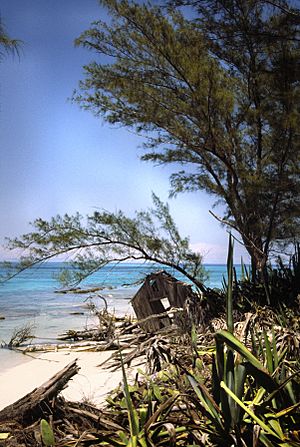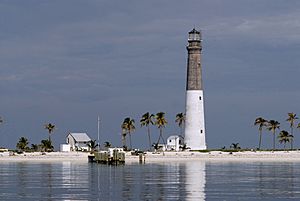Loggerhead Key facts for kids

An aerial view of Loggerhead Key, Dry Tortugas
|
|
| Geography | |
|---|---|
| Location | Dry Tortugas at the end of Florida Keys, United States |
| Coordinates | 24°37′57″N 82°55′14″W / 24.6323745°N 82.9206767°W |
| Archipelago | Florida Keys |
| Adjacent bodies of water | Gulf of Mexico |
| Total islands | 7 |
| Major islands | Garden Key |
| Area | 49 acres (20 ha) |
| Highest elevation | 10 ft (3 m) |
| Administration | |
|
United States
|
|
| State | Florida |
| County | Monroe County |
| Census County Division | Lower Keys |
| Demographics | |
| Population |
|
| Additional information | |
| Time zone | |
| • Summer (DST) | |
Loggerhead Key is a beautiful, uninhabited tropical island. It's part of the Dry Tortugas National Park islands, located in the Gulf of Mexico. This island is about 49 acres (19.8 hectares) big, making it the largest island in the Dry Tortugas group.
Even though no one lives there permanently, Loggerhead Key welcomes visitors. People come for day trips or even to camp overnight. The island has a few buildings, including the Dry Tortugas Light lighthouse and a house for the lighthouse keeper built in the 1920s. Loggerhead Key gets its fresh drinking water from the ocean using a special process called desalination. It also uses solar power for electricity. From 1904 to 1939, a place called the Carnegie Marine Biological Laboratory used to operate here.
Contents
Climate and Weather
Loggerhead Key has a tropical savanna climate. This means the weather is warm all year round. Summers are long and hot. The rainy season happens from June to October, but it doesn't rain as much here as in other parts of Florida.
Loggerhead Key is likely the driest spot in Florida. It gets the least amount of rain because it's far from the Florida mainland. On the mainland, afternoon thunderstorms often form easily over the land.
| Climate data for Loggerhead Key | |||||||||||||
|---|---|---|---|---|---|---|---|---|---|---|---|---|---|
| Month | Jan | Feb | Mar | Apr | May | Jun | Jul | Aug | Sep | Oct | Nov | Dec | Year |
| Mean daily maximum °F (°C) | 74 (23) |
76 (24) |
78 (26) |
83 (28) |
86 (30) |
90 (32) |
91 (33) |
92 (33) |
90 (32) |
85 (29) |
79 (26) |
76 (24) |
83 (28) |
| Daily mean °F (°C) | 69.5 (20.8) |
70.5 (21.4) |
72.5 (22.5) |
77 (25) |
80 (27) |
83.5 (28.6) |
84.5 (29.2) |
85.5 (29.7) |
83.5 (28.6) |
80 (27) |
74.5 (23.6) |
71.5 (21.9) |
77.7 (25.4) |
| Mean daily minimum °F (°C) | 65 (18) |
65 (18) |
67 (19) |
71 (22) |
74 (23) |
77 (25) |
78 (26) |
79 (26) |
77 (25) |
75 (24) |
70 (21) |
67 (19) |
72 (22) |
| Average precipitation inches (mm) | 2.7 (69) |
1.8 (46) |
2 (51) |
1.9 (48) |
1.9 (48) |
3.3 (84) |
2.8 (71) |
3.7 (94) |
6 (150) |
4.6 (120) |
1.9 (48) |
2.1 (53) |
34.7 (882) |
| Average precipitation days | 5 | 3 | 3 | 2 | 4 | 6 | 6 | 8 | 9 | 7 | 3 | 4 | 60 |
Why the Name Loggerhead Key?
Loggerhead Key gets its name from the loggerhead sea turtle. This amazing marine reptile is an endangered type of sea turtle. It can be found all over the world.
Amazing Coral Reefs
The Little Africa coral reef is found near Loggerhead Key. Coral reefs are like underwater cities built by tiny animals called polyps. This reef is home to many different kinds of tropical fish, spiny lobsters, and young game fish. You can see various types of stony and soft corals here.
Plants and Animals
Loggerhead Key is home to many interesting plants and animals.
Island Plants
The plants on Loggerhead Key include mangroves, coconut palms, geiger trees, morning glory, sea lavender, and cactus. In the 1840s, the island was covered with white buttonwood trees. However, people living on the island at that time either burned them or cut them down. In the early 1900s, bay cedar trees also grew on the island.
Island Animals and Sea Turtle Reproduction
Many animals live on Loggerhead Key. Sea turtles are a big part of the island's wildlife. Park rangers from the Dry Tortugas National Park carefully watch these turtles. They keep track of how many nests are made and how many baby turtles hatch. The loggerhead sea turtle, which the island is named after, is also found here.
In August 2016, a marine biologist from the National Park reported that there were 113 loggerhead turtle nests on the island. This was the highest number of nests ever recorded for that time! The island is also home to brown pelicans.
Former Monkey Home
In 1972, a large group of rhesus macaque monkeys were brought to Loggerhead Key. These monkeys were brought from India. Between 1987 and 1990, about 1,322 of these monkeys lived on the island.
Dry Tortugas Light
The Dry Tortugas Light is a lighthouse located on Loggerhead Key. It started guiding ships in 1858. The lighthouse was officially stopped from operating in 2014.
Carnegie Marine Biology Lab
The Carnegie Marine Biological Laboratory was also known as the Tortugas Laboratory. It was a special place for marine biology research. This lab was built on the northern part of Loggerhead Key and operated from 1904 to 1939. The Carnegie Institution of Washington built and ran this facility.
The Carnegie Marine Biological Laboratory did some of the first research on mangroves and coral reefs in the Western Hemisphere. They also studied other marine life around the Loggerhead Key coral reefs. Researchers even took underwater color and black-and-white photos there. Because of safety worries during the hurricane season, research only happened in the late spring and summer months.






